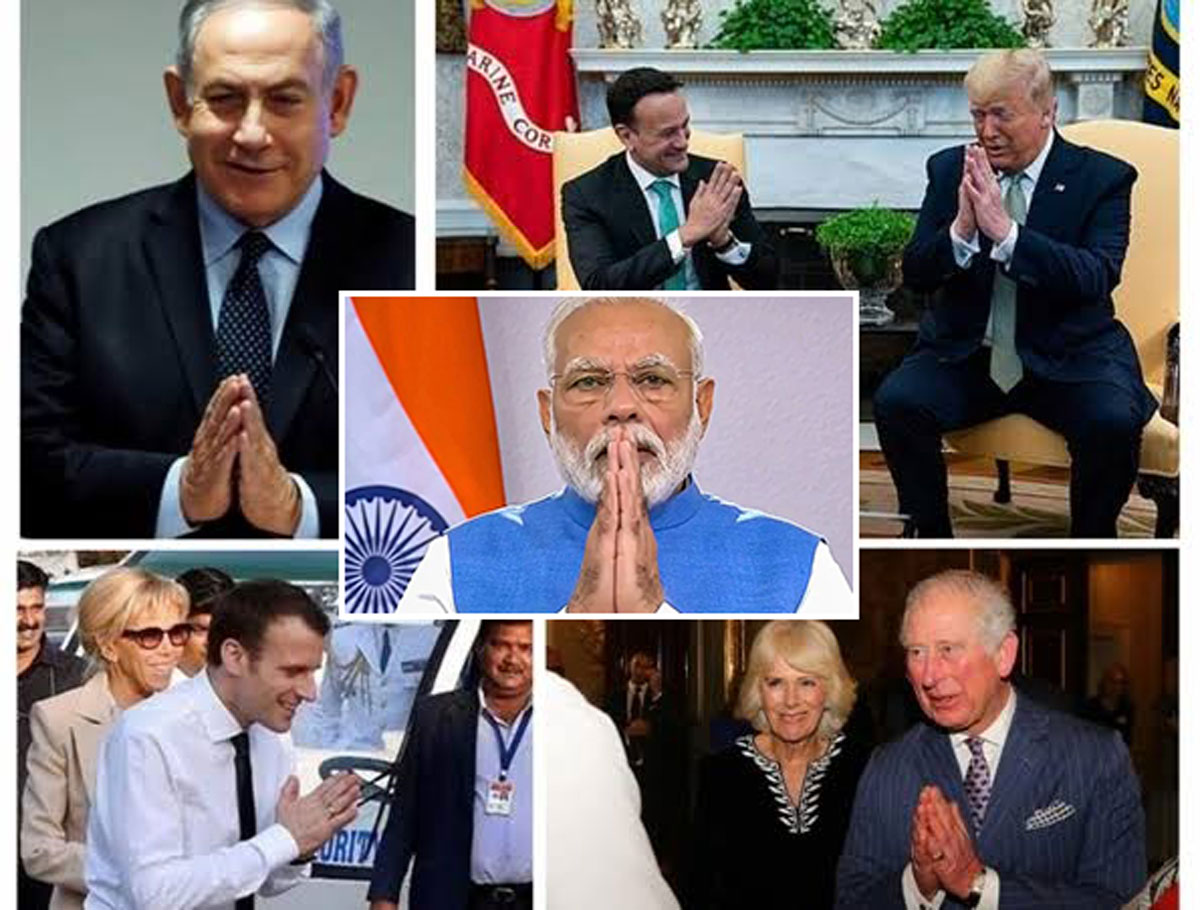Capt. Krishan Sharma
India Post News Service
Due to coronavirus, suddenly the Indian greeting ’Namaste’ a gesture with joined hands and a gentle bow, has become the preferred greeting used by world leaders lately, including US President Donald Trump, to avoid bodily contact. Even though Indians inherited this gesture thousands of years ago, they have been greeting with a normal handshake as practiced in the west, forgetting their own culture and traditions.
One would ask, how the tradition evolved? There are thousands of meaning to this symbol adopted by ancient Hindu traditions. Famous are those attached to the way of life, deep spiritual thought and also for health and yogic postures. You can also see this ‘Mudra’ or gesture, in the ancient statues and images of India. Even in Christian faith, one can see the images of Christ with joined hands. The same goes for Buddhists, which is an extension of Hindu traditions.
Namaste is a Sanskrit word that translates as “I bow to you.” (Nama meaning bow, as means I, and to means you). So quite literally, Namaste translates as “bow me you”, or “I bow to you”. The term is an ancient Sanskrit salutation that is still commonly used in many parts of India as a greeting.
It’s likely that you’ve heard or seen some of the more common translations, or versions of them, without even realizing it. “My soul honors your soul”, “the Divine in me honors the Divine in you”, “the Light in me recognizes the Light in you” or “the spirit within me sees the spirit within you” are all variations of the same.
The word Namaste is also often accompanied by the gesture of anjali mudra, in which palms press together in prayer at the heart centre and with a slight bow of the chin towards the chest. In the west, we interpret this gesture as one of prayer, but within the yoga practice, it represents an intention to honor, celebrate, appreciate and respect. Anjali mudra can be found throughout our physical yoga practice as well, for example in Mountain Pose (Tadasana), Tree Pose (Vrksasana) and in Sun Salutation (Surya Namaskar).
But empty gestures feel empty and the key to communicating Namaste with sincerity and truth is to really feel and experience its true meaning when performing the gesture. Indeed, both the word Namaste and the gesture of anjali mudra represents the belief that the Divine lives within each one of us at the heart chakra. So with eyes closed and palms gently and lovingly pressed together, at the heart center, allow your awareness to rest within the space beneath your hands, maintaining awareness of the potential of what sits within that space. Slightly bowing your head, silently repeat the word Namaste internally to yourself – just as you express externally to the person in front of you.
It is the very essence of Yoga practice to recognize the Divine within each other and in the other.
Is Namaste is a widely used greeting in India? The short answer to this question is: yes, Namaste is also used at parting as in ‘goodbye’.This is because it does not mean either ‘hello’ or ‘goodbye’ but ‘I bow to the divine in you’. So it is a respectful and positive thing to say both in greeting and in parting.
If you are accustomed to the South Asian side of the world, or with yoga that is spreading across the world, then you will realize that ‘Namaste’ or ‘Namaskar’ is a common form of greeting. The culture dates back billions of years ago, according to Hinduism, where even the gods and demigods used the kind of salutation to greet each other. It is used on a daily basis in countries like India and Nepal as a kind of standard greeting, especially amongst the Hindus.
But it is more than just a greeting; it has a deeper meaning and a deeper significance to humans. You are acknowledging the divinity in the other person. Recognizing that the almighty God dwells in all human and other living beings. That is the main reason many Hindus don’t eat meat or kill living creatures. Since the cow provides milk it symbolizes the human mother and for the same reason, Hindus don’t kill a cow and pray to it in reverence.
Namaskar: My soul recognizes your soul. I honor the light, love, beauty, truth, and kindness within you because it is also within me. In sharing these things, there is no distance and no difference between us. We are the same. We are one.
There is a subtle difference between ‘Namaste’ and ‘Namaskaar,’ however. You are greeting the source of all when you say ‘Namaskaar,’ and with ‘Namaste,’ you are greeting the form of Soul. Source – Meaning of Namaste Youaredevelopingconnection in spiritual dimension When the person acknowledges back your salutation with a ‘Namaste’ or ‘Namaskaar,’ you are developing a spiritual connection with the other person. According to Hinduism, this spiritual connection boosts the positive aura and the relationship with the formless soul. You are in the Spiritual Path of Growth. The etymology of the words comes from Sanskrit word, ‘Namaha,’ which is defined in the Science of Justice as “a physical action expressing that you are superior to me in all qualities and in every way.” This modest definition, when acknowledged during the moment of greeting, helps in developing an attitude of surrender and gratitude towards fellow human beings.
When a person greeting considers the other person as superior to him/her, then it helps in checking one’s ego and evoking a sense of humility from within, a common trait of being truly ‘human.’ You are transferring only positive energy The greeting is commonly done with both hands pressed together with both palms in a vertical position, placed in front of the chest, bowing the head, and uttering the word ‘Namaste’ or ‘Namaskaar.’ This gesture is known as the ‘Namaskaar’ mudra.
In Hinduism, it is believed that a living body is made up of five different elements:
- Agni – Fire
- Pruthvittattva/Bhumi- Earth
- Pavan/Marut – Air
- Jal – Water
- Akastattva/Sunya – Vacuum
The vacuum is a constant flow of energy in the human form of the soul. The element ‘Vacuum’ cannot be harmed even though the entire Universe is destroyed. So, by joining hands with the ‘Namaskaar’ mudra, you are relating to the ‘Vacuum’ element of the universe, and you are absorbing a level of ‘Divine consciousness’ into your body. By uttering the word, you are connecting to the Earth element in the universe. When these two elements of energy connect, other elements also start connecting with the person. As a result, there is a flow of spiritual energy into the individual through the cosmic universe. With the shaking of hands, there might be the transfer of either positive or negative energy. But with ‘Namaste’ and ‘Namaskaar,’ there is only a transfer of positive energy. While there are spiritual benefits, the gesture also has pros in terms of physical science. Joining both hands and joining the tips of all fingers together activates the pressure points in the ears, eyes and the part of the mind associated with memory.
Since there is no physical contact with the greeting, there is less chance of germs and diseases being transferred. There must have been several reasons for the ancient Hindus to adopt these ‘Mudras’ or ‘Gestures’, but for now, we are grateful and glad to be able to share that our customs and traditions are helping to stop the spread of coronavirus.
(With Inputs from Wikipedia & Agencies)






